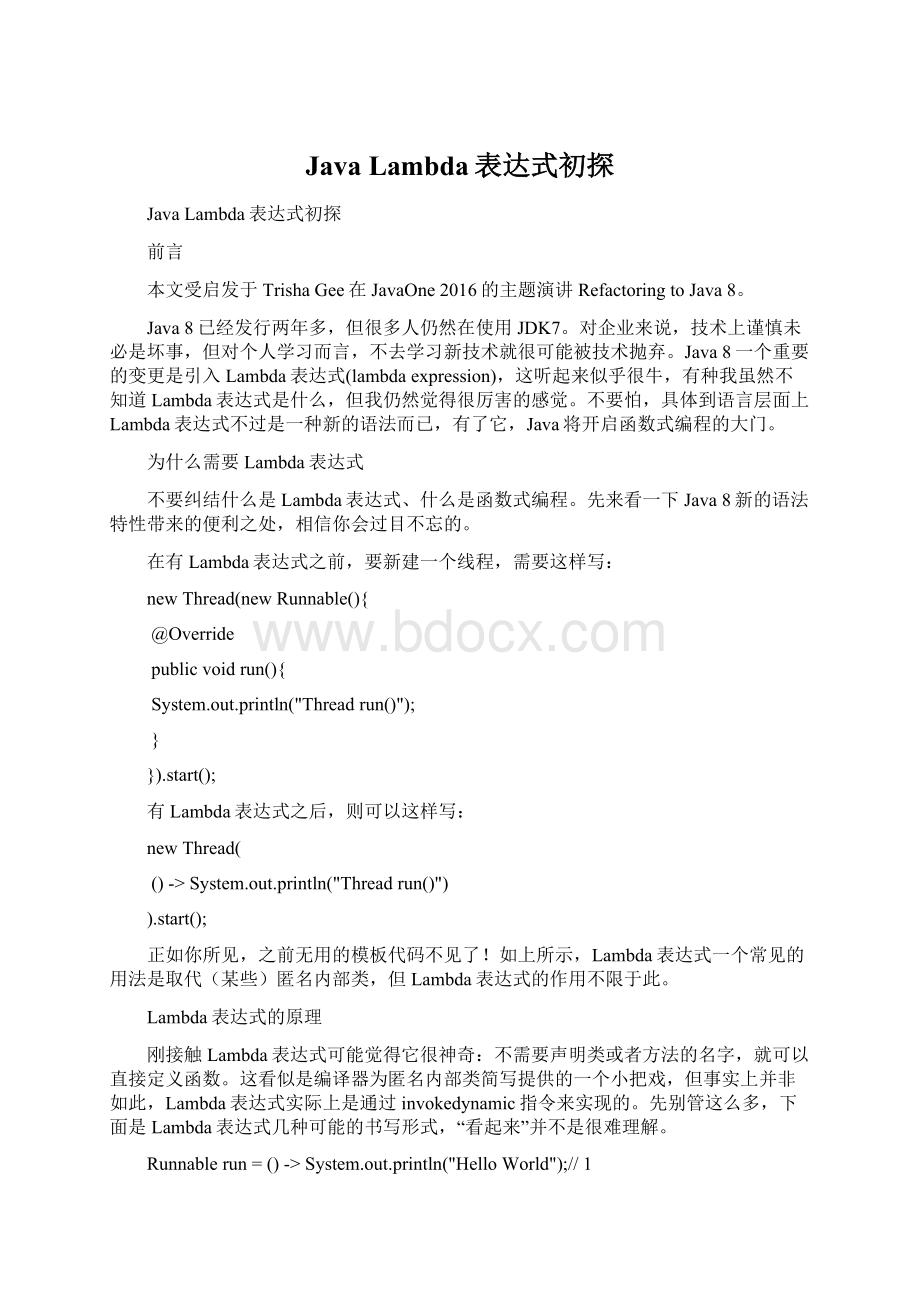Java Lambda表达式初探Word文件下载.docx
《Java Lambda表达式初探Word文件下载.docx》由会员分享,可在线阅读,更多相关《Java Lambda表达式初探Word文件下载.docx(28页珍藏版)》请在冰豆网上搜索。

()->
)
).start();
正如你所见,之前无用的模板代码不见了!
如上所示,Lambda表达式一个常见的用法是取代(某些)匿名内部类,但Lambda表达式的作用不限于此。
Lambda表达式的原理
刚接触Lambda表达式可能觉得它很神奇:
不需要声明类或者方法的名字,就可以直接定义函数。
这看似是编译器为匿名内部类简写提供的一个小把戏,但事实上并非如此,Lambda表达式实际上是通过invokedynamic指令来实现的。
先别管这么多,下面是Lambda表达式几种可能的书写形式,“看起来”并不是很难理解。
Runnablerun=()->
HelloWorld"
//1
ActionListenerlistener=event->
buttonclicked"
//2
RunnablemultiLine=()->
{//3
Hello"
World"
};
BinaryOperator<
Long>
add=(Longx,Longy)->
x+y;
//4
addImplicit=(x,y)->
//5
通过上例可以发现:
Lambda表达式是有类型的,赋值操作的左边就是类型。
Lambda表达式的类型实际上是对应接口的类型。
Lambda表达式可以包含多行代码,需要用大括号把代码块括起来,就像写函数体那样。
大多数时候,Lambda表达式的参数表可以省略类型,就像代码2和5那样。
这得益于javac的类型推导机制,编译器可以根据上下文推导出类型信息。
表面上看起来每个Lambda表达式都是原来匿名内部类的简写形式,该内部类实现了某个函数接口(FunctionalInterface),但事实比这稍微复杂一些,这里不再展开。
所谓函数接口是指内部只有一个接口函数的接口。
Java是强类型语言,无论有没有显式指明,每个变量和对象都必须有明确的类型,没有显式指定的时候编译器会尝试确定类型。
Lambda表达式的类型就是对应函数接口的类型。
Lambda表达式和Stream
Lambda表达式的另一个重要用法,是和Stream一起使用。
Streamisasequenceofelementssupportingsequentialandparallelaggregateoperations。
Stream就是一组元素的序列,支持对这些元素进行各种操作,而这些操作是通过Lambda表达式指定的。
可以把Stream看作JavaCollection的一种视图,就像迭代器是容器的一种视图那样(但Stream不会修改容器中的内容)。
下面例子展示了Stream的常见用法。
例子1
假设需要从一个字符串列表中选出以数字开头的字符串并输出,Java7之前需要这样写:
List<
String>
list=Arrays.asList("
1one"
"
two"
three"
4four"
for(Stringstr:
list){
if(Character.isDigit(str.charAt(0))){
System.out.println(str);
}
而Java8就可以这样写:
list.stream()//1.得到容器的Steam
.filter(str->
Character.isDigit(str.charAt(0)))//2.选出以数字开头的字符串
.forEach(str->
System.out.println(str));
//3.输出字符串
上述代码首先1.调用List.stream()方法得到容器的Stream,2.然后调用filter()方法过滤出以数字开头的字符串,3.最后调用forEach()方法输出结果。
使用Stream有两个明显的好处:
减少了模板代码,只用Lambda表达式指明所需操作,代码语义更加明确、便于阅读。
将外部迭代改成了Stream的内部迭代,方便了JVM本身对迭代过程做优化(比如可以并行迭代)。
例子2
假设需要从一个字符串列表中,选出所有不以数字开头的字符串,将其转换成大写形式,并把结果放到新的集合当中。
Java8书写的代码如下:
Set<
newList=
list.stream()//1.得到容器的Stream
!
Character.isDigit(str.charAt(0)))//2.选出不以数字开头的字符串
.map(String:
:
toUpperCase)//3.转换成大写形式
.collect(Collectors.toSet());
//4.生成结果集
上述代码首先1.调用List.stream()方法得到容器的Stream,2.然后调用filter()方法选出不以数字开头的字符串,3.之后调用map()方法将字符串转换成大写形式,4.最后调用collect()方法将结果转换成Set。
这个例子还向我们展示了方法引用(methodreferences,代码中标号3处)以及收集器(Collector,代码中标号4处)的用法,这里不再展开说明。
通过这个例子我们看到了Stream链式操作,即多个操作可以连成一串。
不用担心这会导致对容器的多次迭代,因为不是每个Stream的操作都会立即执行。
Stream的操作分成两类,一类是中间操作(intermediateoperations),另一类是结束操作(terminaloperation),只有结束操作才会导致真正的代码执行,中间操作只会做一些标记,表示需要对Stream进行某种操作。
这意味着可以在Stream上通过关联多种操作,但最终只需要一次迭代。
如果你熟悉SparkRDD,对此应该并不陌生。
参考文献:
compact1,compact2,compact3
java.util.stream
InterfaceStream<
T>
TypeParameters:
T-thetypeofthestreamelements
AllSuperinterfaces:
AutoCloseable,BaseStream<
T,Stream<
>
publicinterfaceStream<
extendsBaseStream<
Asequenceofelementssupportingsequentialandparallelaggregateoperations.ThefollowingexampleillustratesanaggregateoperationusingStreamandIntStream:
intsum=widgets.stream()
.filter(w->
w.getColor()==RED)
.mapToInt(w->
w.getWeight())
.sum();
Inthisexample,widgetsisaCollection<
Widget>
.WecreateastreamofWidgetobjectsviaCollection.stream(),filterittoproduceastreamcontainingonlytheredwidgets,andthentransformitintoastreamofintvaluesrepresentingtheweightofeachredwidget.Thenthisstreamissummedtoproduceatotalweight.
InadditiontoStream,whichisastreamofobjectreferences,thereareprimitivespecializationsforIntStream,LongStream,andDoubleStream,allofwhicharereferredtoas"
streams"
andconformtothecharacteristicsandrestrictionsdescribedhere.
Toperformacomputation,streamoperationsarecomposedintoastreampipeline.Astreampipelineconsistsofasource(whichmightbeanarray,acollection,ageneratorfunction,anI/Ochannel,etc),zeroormoreintermediateoperations(whichtransformastreamintoanotherstream,suchasfilter(Predicate)),andaterminaloperation(whichproducesaresultorside-effect,suchascount()orforEach(Consumer)).Streamsarelazy;
computationonthesourcedataisonlyperformedwhentheterminaloperationisinitiated,andsourceelementsareconsumedonlyasneeded.
Collectionsandstreams,whilebearingsomesuperficialsimilarities,havedifferentgoals.Collectionsareprimarilyconcernedwiththeefficientmanagementof,andaccessto,theirelements.Bycontrast,streamsdonotprovideameanstodirectlyaccessormanipulatetheirelements,andareinsteadconcernedwithdeclarativelydescribingtheirsourceandthecomputationaloperationswhichwillbeperformedinaggregateonthatsource.However,iftheprovidedstreamoperationsdonotofferthedesiredfunctionality,theBaseStream.iterator()andBaseStream.spliterator()operationscanbeusedtoperformacontrolledtraversal.
Astreampipeline,likethe"
widgets"
exampleabove,canbeviewedasaqueryonthestreamsource.Unlessthesourcewasexplicitlydesignedforconcurrentmodification(suchasaConcurrentHashMap),unpredictableorerroneousbehaviormayresultfrommodifyingthestreamsourcewhileitisbeingqueried.
Moststreamoperationsacceptparametersthatdescribeuser-specifiedbehavior,suchasthelambdaexpressionw->
w.getWeight()passedtomapToIntintheexampleabove.Topreservecorrectbehavior,thesebehavioralparameters:
mustbenon-interfering(theydonotmodifythestreamsource);
and
inmostcasesmustbestateless(theirresultshouldnotdependonanystatethatmightchangeduringexecutionofthestreampipeline).
SuchparametersarealwaysinstancesofafunctionalinterfacesuchasFunction,andareoftenlambdaexpressionsormethodreferences.Unlessotherwisespecifiedtheseparametersmustbenon-null.
Astreamshouldbeoperatedon(invokinganintermediateorterminalstreamoperation)onlyonce.Thisrulesout,forexample,"
forked"
streams,wherethesamesourcefeedstwoormorepipelines,ormultipletraversalsofthesamestream.AstreamimplementationmaythrowIllegalStateExceptionifitdetectsthatthestreamisbeingreused.However,sincesomestreamoperationsmayreturntheirreceiverratherthananewstreamobject,itmaynotbepossibletodetectreuseinallcases.
StreamshaveaBaseStream.close()methodandimplementAutoCloseable,butnearlyallstreaminstancesdonotactuallyneedtobeclosedafteruse.Generally,onlystreamswhosesourceisanIOchannel(suchasthosereturnedbyFiles.lines(Path,Charset))willrequireclosing.Moststreamsarebackedbycollections,arrays,orgeneratingfunctions,whichrequirenospecialresourcemanagement.(Ifastreamdoesrequireclosing,itcanbedeclaredasaresourceinatry-with-resourcesstatement.)
Streampipelinesmayexecuteeithersequentiallyorinparallel.Thisexecutionmodeisapropertyofthestream.Streamsarecreatedwithaninitialchoiceofsequentialorparallelexecution.(Forexample,Collection.stream()createsasequentialstream,andCollection.parallelStream()createsaparallelone.)ThischoiceofexecutionmodemaybemodifiedbytheBaseStream.sequential()orBaseStream.parallel()methods,andmaybequeriedwiththeBaseStream.isParallel()method.
Since:
1.8
SeeAlso:
IntStream,LongStream,DoubleStream,java.util.stream
NestedClassSummary
NestedClasses
ModifierandTypeInterfaceandDescription
staticinterfaceStream.Builder<
AmutablebuilderforaStream.
MethodSummary
AllMethodsStaticMethodsInstanceMethodsAbstractMethodsDefaultMethods
ModifierandTypeMethodandDescription
booleanallMatch(Predicate<
?
superT>
predicate)
Returnswhetherallelementsofthisstreammatchtheprovidedpredicate.
booleananyMatch(Predicate<
Returnswhetheranyelementsofthisstreammatchtheprovidedpredicate.
static<
Stream.Builder<
builder()
ReturnsabuilderforaStream.
<
R,A>
Rcollect(Collector<
superT,A,R>
collector)
PerformsamutablereductionoperationontheelementsofthisstreamusingaCollector.
R>
Rcollect(Supplier<
supplier,BiConsumer<
R,?
accumulator,BiConsumer<
R,R>
combiner)
Performsamutablereductionoperationontheelementsofthisstream.
Stream<
concat(Stream<
extendsT>
a,Stream<
b)
Createsalazilyconcatenatedstreamwhoseelementsarealltheelementsofthefirststreamfollowedbyalltheelementsofthesecondstream.
longcount()
Returnsthecountofelementsinthisstream.
Stream<
distinct()
Returnsastreamconsistingofthedistinctelements(accordingtoObject.equals(Object))ofthisstream.
empty()
ReturnsanemptysequentialStream.
filter(Predicate<
Returnsastreamconsistingoftheelementsofthisstreamthatmatchthegivenpredicate.
Optional<
findAny()
ReturnsanOptionaldescribingsomeelementofthestream,oranemptyOptionalifthestreamisempty.
findFirst()
ReturnsanOptionaldescribingthefirstelementofthisstream,oranemptyOptionalifthestreamisempty.
flatMap